Australian Accounting Practices: A Report on Current Trends
VerifiedAdded on 2019/10/30

Name of the Student:
Name of the University:
Author’s Note:
Paraphrase This Document
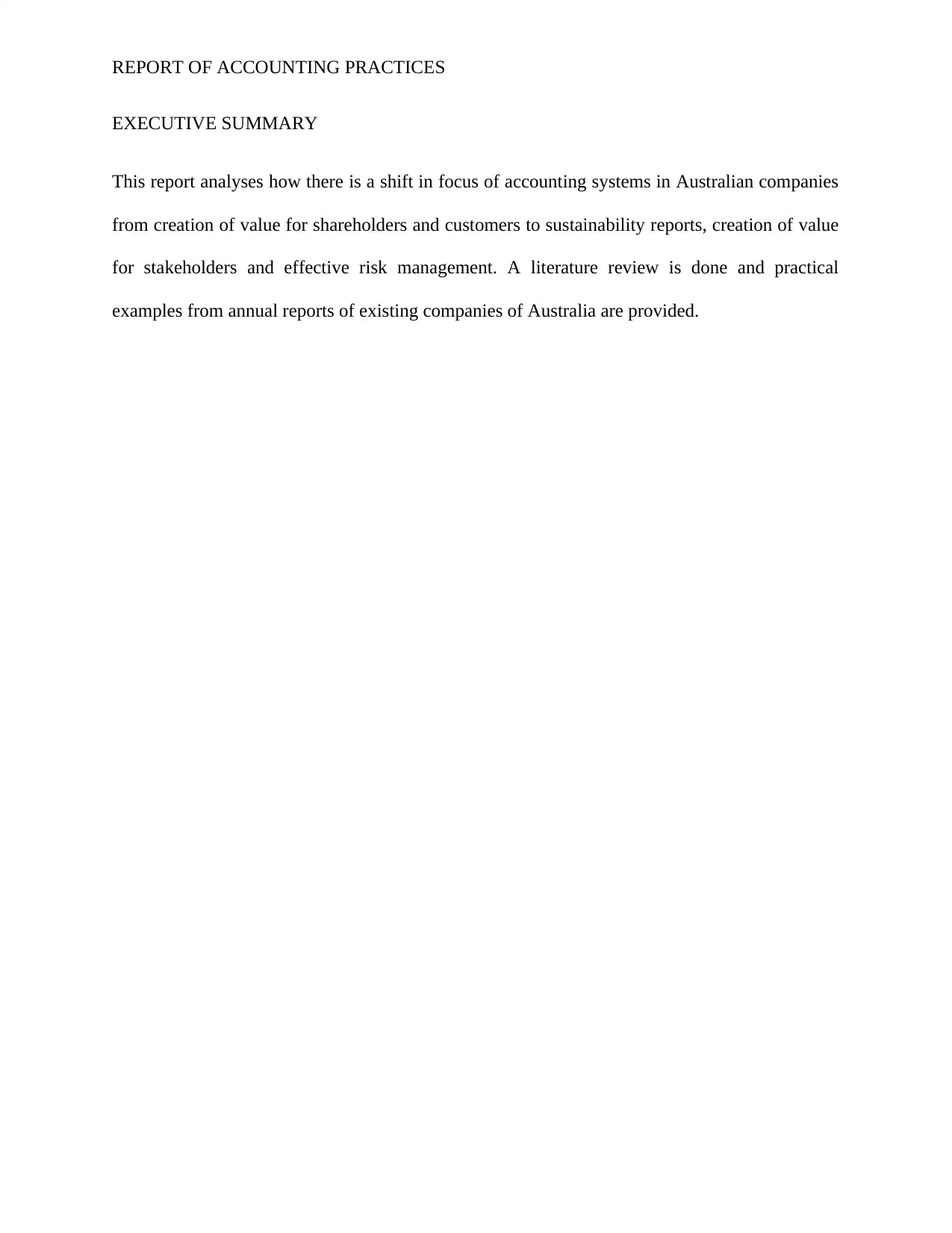
EXECUTIVE SUMMARY
This report analyses how there is a shift in focus of accounting systems in Australian companies
from creation of value for shareholders and customers to sustainability reports, creation of value
for stakeholders and effective risk management. A literature review is done and practical
examples from annual reports of existing companies of Australia are provided.
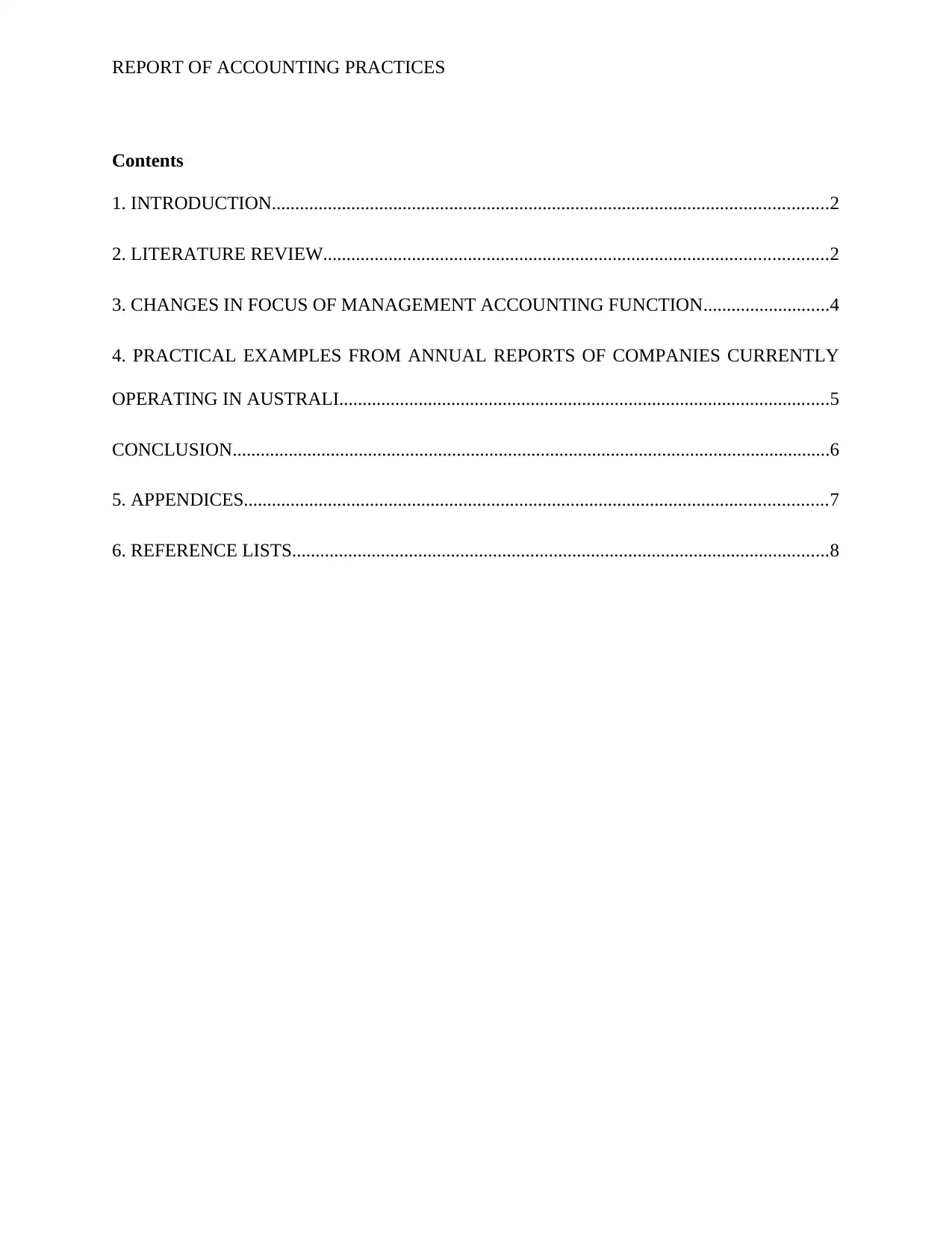
Contents
1. INTRODUCTION.......................................................................................................................2
2. LITERATURE REVIEW............................................................................................................2
3. CHANGES IN FOCUS OF MANAGEMENT ACCOUNTING FUNCTION...........................4
4. PRACTICAL EXAMPLES FROM ANNUAL REPORTS OF COMPANIES CURRENTLY
OPERATING IN AUSTRALI.........................................................................................................5
CONCLUSION................................................................................................................................6
5. APPENDICES.............................................................................................................................7
6. REFERENCE LISTS...................................................................................................................8
⊘ This is a preview!⊘
Do you want full access?
Subscribe today to unlock all pages.

Trusted by 1+ million students worldwide
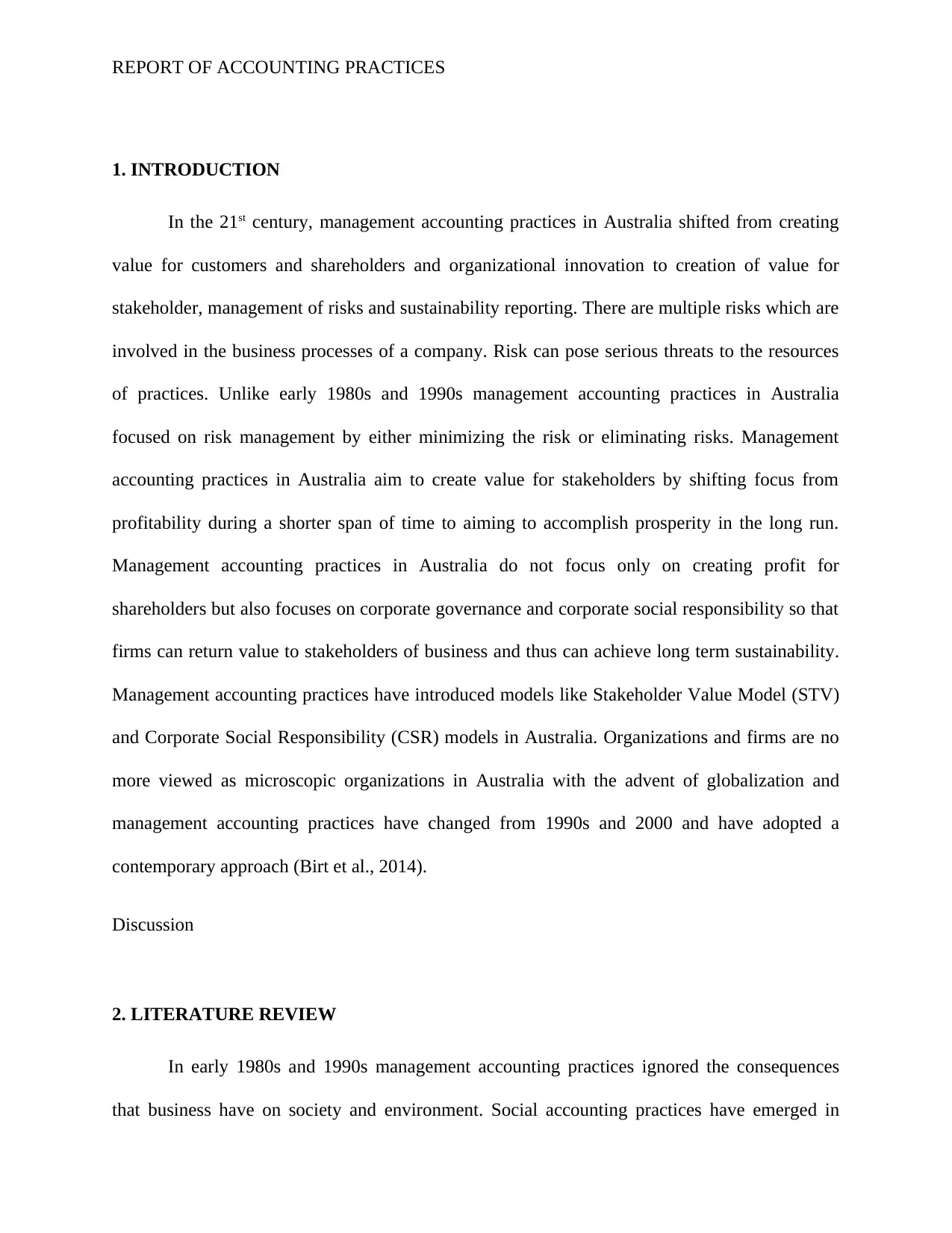
1. INTRODUCTION
In the 21st century, management accounting practices in Australia shifted from creating
value for customers and shareholders and organizational innovation to creation of value for
stakeholder, management of risks and sustainability reporting. There are multiple risks which are
involved in the business processes of a company. Risk can pose serious threats to the resources
of practices. Unlike early 1980s and 1990s management accounting practices in Australia
focused on risk management by either minimizing the risk or eliminating risks. Management
accounting practices in Australia aim to create value for stakeholders by shifting focus from
profitability during a shorter span of time to aiming to accomplish prosperity in the long run.
Management accounting practices in Australia do not focus only on creating profit for
shareholders but also focuses on corporate governance and corporate social responsibility so that
firms can return value to stakeholders of business and thus can achieve long term sustainability.
Management accounting practices have introduced models like Stakeholder Value Model (STV)
and Corporate Social Responsibility (CSR) models in Australia. Organizations and firms are no
more viewed as microscopic organizations in Australia with the advent of globalization and
management accounting practices have changed from 1990s and 2000 and have adopted a
contemporary approach (Birt et al., 2014).
Discussion
2. LITERATURE REVIEW
In early 1980s and 1990s management accounting practices ignored the consequences
that business have on society and environment. Social accounting practices have emerged in
Paraphrase This Document
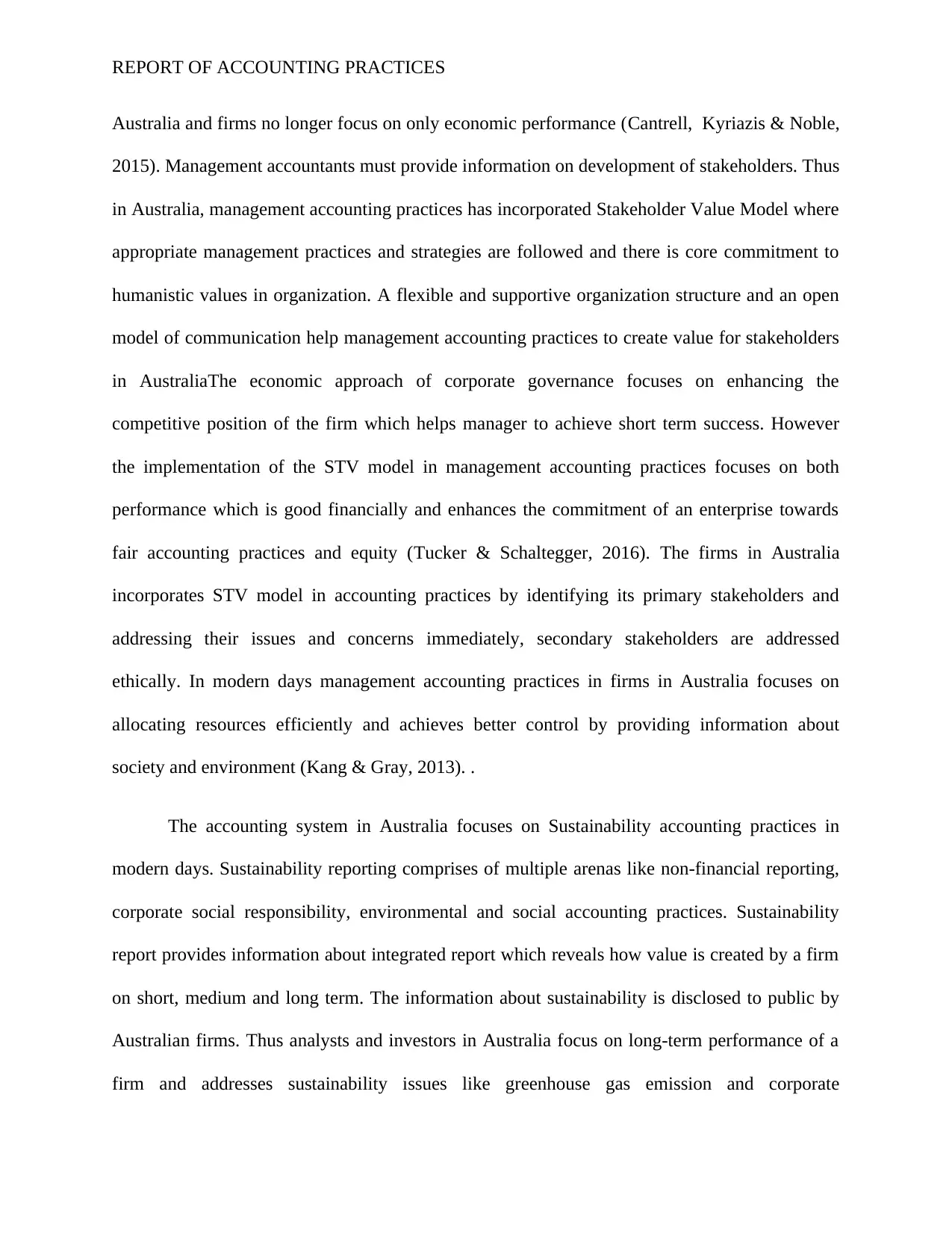
Australia and firms no longer focus on only economic performance (Cantrell, Kyriazis & Noble,
2015). Management accountants must provide information on development of stakeholders. Thus
in Australia, management accounting practices has incorporated Stakeholder Value Model where
appropriate management practices and strategies are followed and there is core commitment to
humanistic values in organization. A flexible and supportive organization structure and an open
model of communication help management accounting practices to create value for stakeholders
in AustraliaThe economic approach of corporate governance focuses on enhancing the
competitive position of the firm which helps manager to achieve short term success. However
the implementation of the STV model in management accounting practices focuses on both
performance which is good financially and enhances the commitment of an enterprise towards
fair accounting practices and equity (Tucker & Schaltegger, 2016). The firms in Australia
incorporates STV model in accounting practices by identifying its primary stakeholders and
addressing their issues and concerns immediately, secondary stakeholders are addressed
ethically. In modern days management accounting practices in firms in Australia focuses on
allocating resources efficiently and achieves better control by providing information about
society and environment (Kang & Gray, 2013). .
The accounting system in Australia focuses on Sustainability accounting practices in
modern days. Sustainability reporting comprises of multiple arenas like non-financial reporting,
corporate social responsibility, environmental and social accounting practices. Sustainability
report provides information about integrated report which reveals how value is created by a firm
on short, medium and long term. The information about sustainability is disclosed to public by
Australian firms. Thus analysts and investors in Australia focus on long-term performance of a
firm and addresses sustainability issues like greenhouse gas emission and corporate
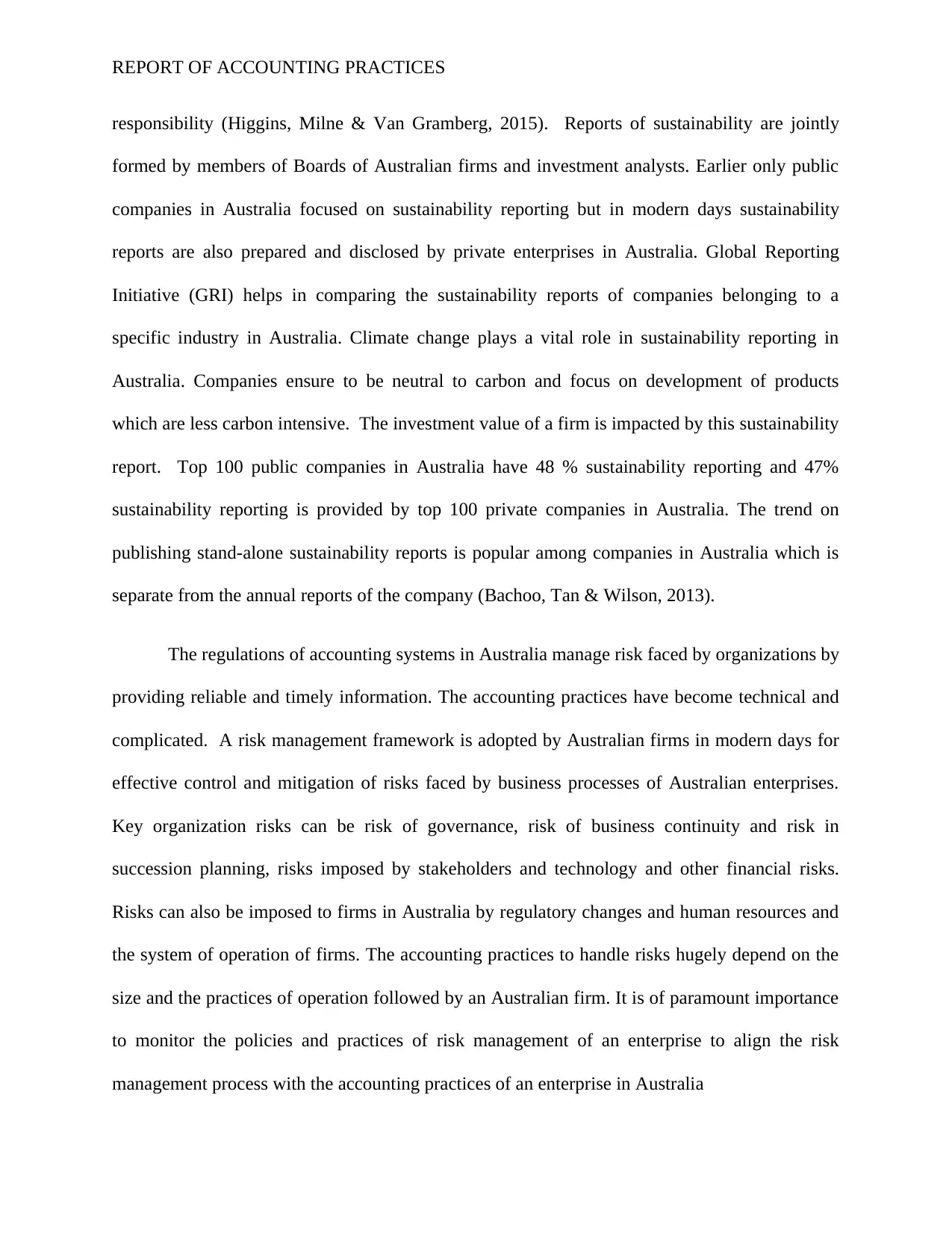
responsibility (Higgins, Milne & Van Gramberg, 2015). Reports of sustainability are jointly
formed by members of Boards of Australian firms and investment analysts. Earlier only public
companies in Australia focused on sustainability reporting but in modern days sustainability
reports are also prepared and disclosed by private enterprises in Australia. Global Reporting
Initiative (GRI) helps in comparing the sustainability reports of companies belonging to a
specific industry in Australia. Climate change plays a vital role in sustainability reporting in
Australia. Companies ensure to be neutral to carbon and focus on development of products
which are less carbon intensive. The investment value of a firm is impacted by this sustainability
report. Top 100 public companies in Australia have 48 % sustainability reporting and 47%
sustainability reporting is provided by top 100 private companies in Australia. The trend on
publishing stand-alone sustainability reports is popular among companies in Australia which is
separate from the annual reports of the company (Bachoo, Tan & Wilson, 2013).
The regulations of accounting systems in Australia manage risk faced by organizations by
providing reliable and timely information. The accounting practices have become technical and
complicated. A risk management framework is adopted by Australian firms in modern days for
effective control and mitigation of risks faced by business processes of Australian enterprises.
Key organization risks can be risk of governance, risk of business continuity and risk in
succession planning, risks imposed by stakeholders and technology and other financial risks.
Risks can also be imposed to firms in Australia by regulatory changes and human resources and
the system of operation of firms. The accounting practices to handle risks hugely depend on the
size and the practices of operation followed by an Australian firm. It is of paramount importance
to monitor the policies and practices of risk management of an enterprise to align the risk
management process with the accounting practices of an enterprise in Australia
⊘ This is a preview!⊘
Do you want full access?
Subscribe today to unlock all pages.

Trusted by 1+ million students worldwide
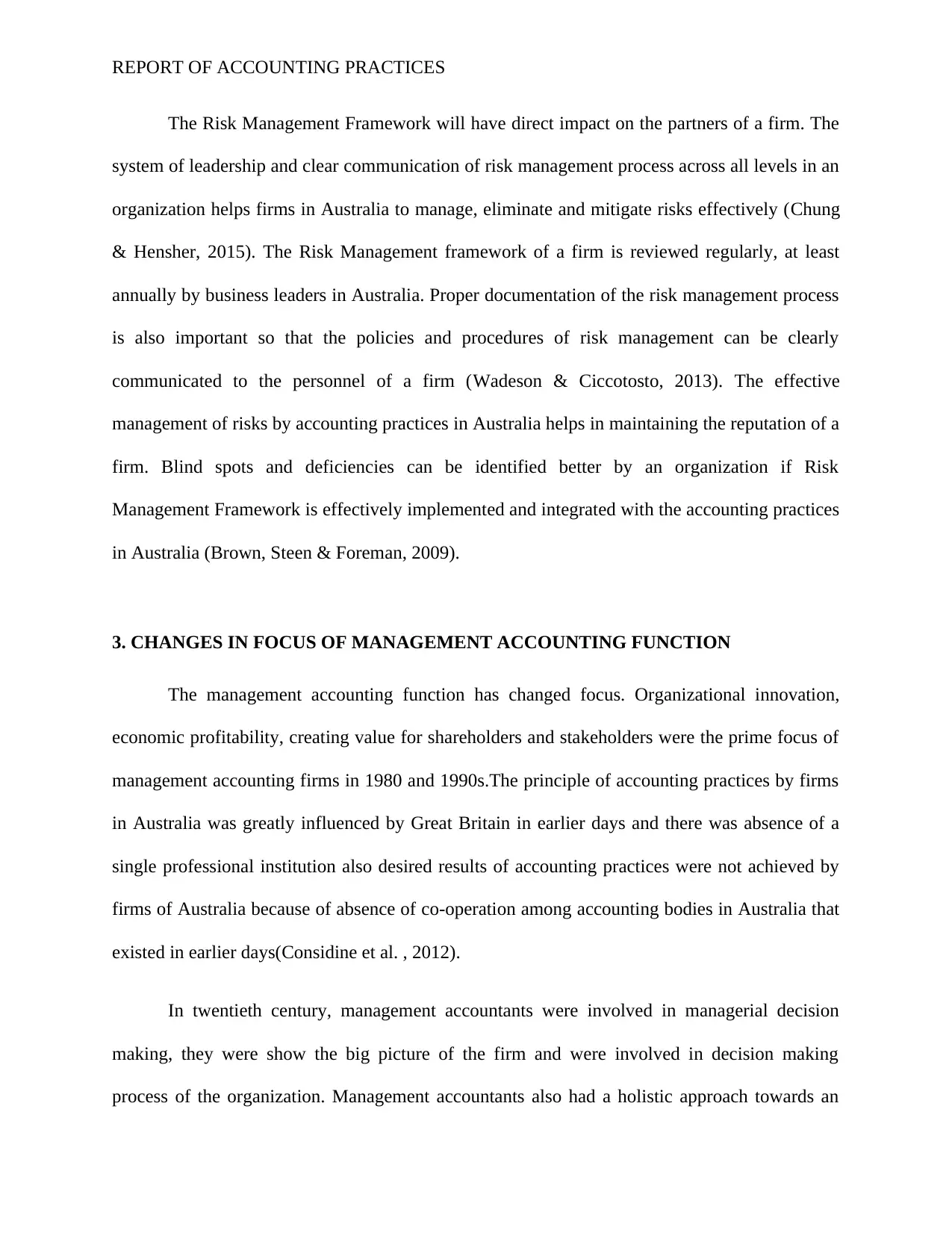
The Risk Management Framework will have direct impact on the partners of a firm. The
system of leadership and clear communication of risk management process across all levels in an
organization helps firms in Australia to manage, eliminate and mitigate risks effectively (Chung
& Hensher, 2015). The Risk Management framework of a firm is reviewed regularly, at least
annually by business leaders in Australia. Proper documentation of the risk management process
is also important so that the policies and procedures of risk management can be clearly
communicated to the personnel of a firm (Wadeson & Ciccotosto, 2013). The effective
management of risks by accounting practices in Australia helps in maintaining the reputation of a
firm. Blind spots and deficiencies can be identified better by an organization if Risk
Management Framework is effectively implemented and integrated with the accounting practices
in Australia (Brown, Steen & Foreman, 2009).
3. CHANGES IN FOCUS OF MANAGEMENT ACCOUNTING FUNCTION
The management accounting function has changed focus. Organizational innovation,
economic profitability, creating value for shareholders and stakeholders were the prime focus of
management accounting firms in 1980 and 1990s.The principle of accounting practices by firms
in Australia was greatly influenced by Great Britain in earlier days and there was absence of a
single professional institution also desired results of accounting practices were not achieved by
firms of Australia because of absence of co-operation among accounting bodies in Australia that
existed in earlier days(Considine et al. , 2012).
In twentieth century, management accountants were involved in managerial decision
making, they were show the big picture of the firm and were involved in decision making
process of the organization. Management accountants also had a holistic approach towards an
Paraphrase This Document
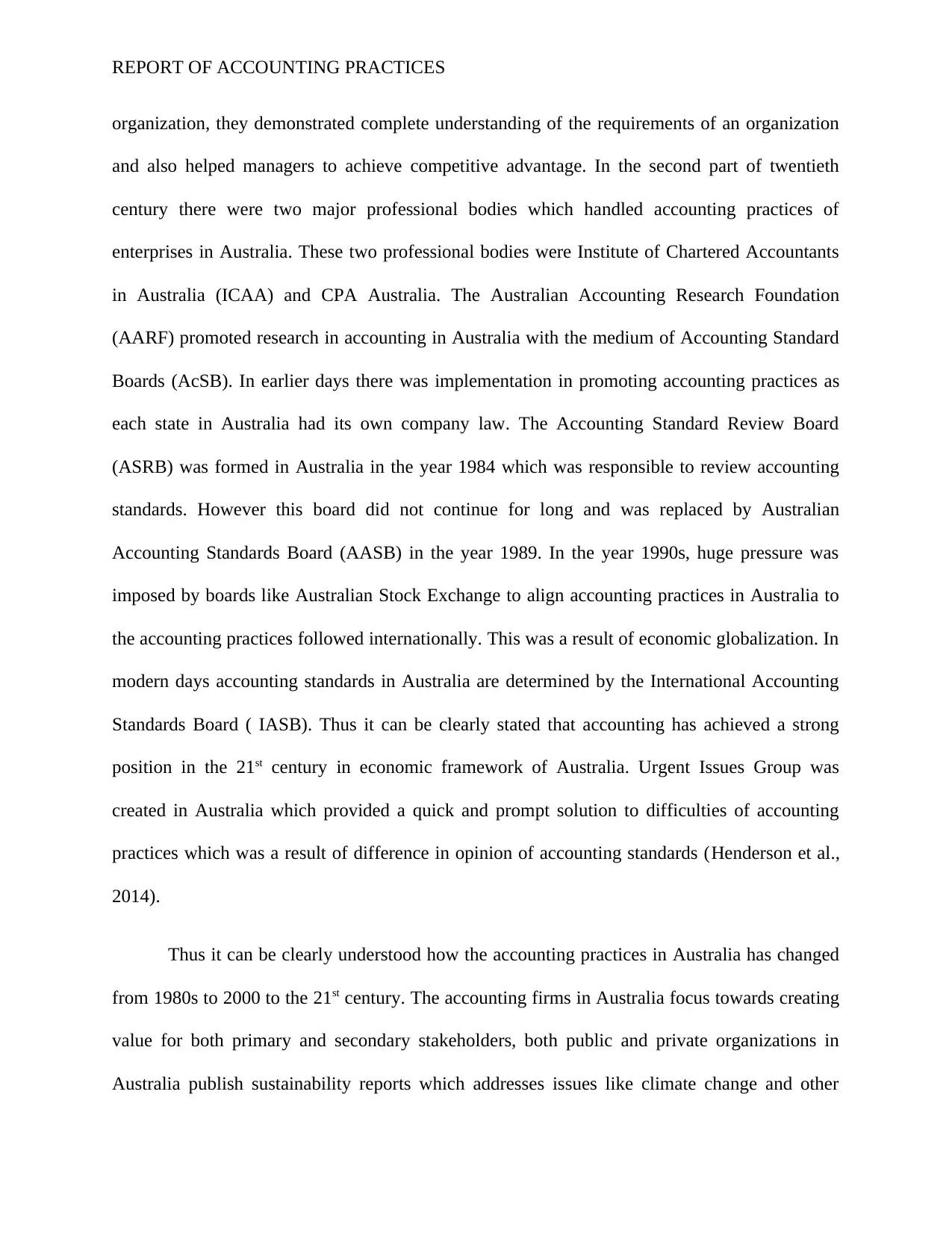
organization, they demonstrated complete understanding of the requirements of an organization
and also helped managers to achieve competitive advantage. In the second part of twentieth
century there were two major professional bodies which handled accounting practices of
enterprises in Australia. These two professional bodies were Institute of Chartered Accountants
in Australia (ICAA) and CPA Australia. The Australian Accounting Research Foundation
(AARF) promoted research in accounting in Australia with the medium of Accounting Standard
Boards (AcSB). In earlier days there was implementation in promoting accounting practices as
each state in Australia had its own company law. The Accounting Standard Review Board
(ASRB) was formed in Australia in the year 1984 which was responsible to review accounting
standards. However this board did not continue for long and was replaced by Australian
Accounting Standards Board (AASB) in the year 1989. In the year 1990s, huge pressure was
imposed by boards like Australian Stock Exchange to align accounting practices in Australia to
the accounting practices followed internationally. This was a result of economic globalization. In
modern days accounting standards in Australia are determined by the International Accounting
Standards Board ( IASB). Thus it can be clearly stated that accounting has achieved a strong
position in the 21st century in economic framework of Australia. Urgent Issues Group was
created in Australia which provided a quick and prompt solution to difficulties of accounting
practices which was a result of difference in opinion of accounting standards (Henderson et al.,
2014).
Thus it can be clearly understood how the accounting practices in Australia has changed
from 1980s to 2000 to the 21st century. The accounting firms in Australia focus towards creating
value for both primary and secondary stakeholders, both public and private organizations in
Australia publish sustainability reports which addresses issues like climate change and other
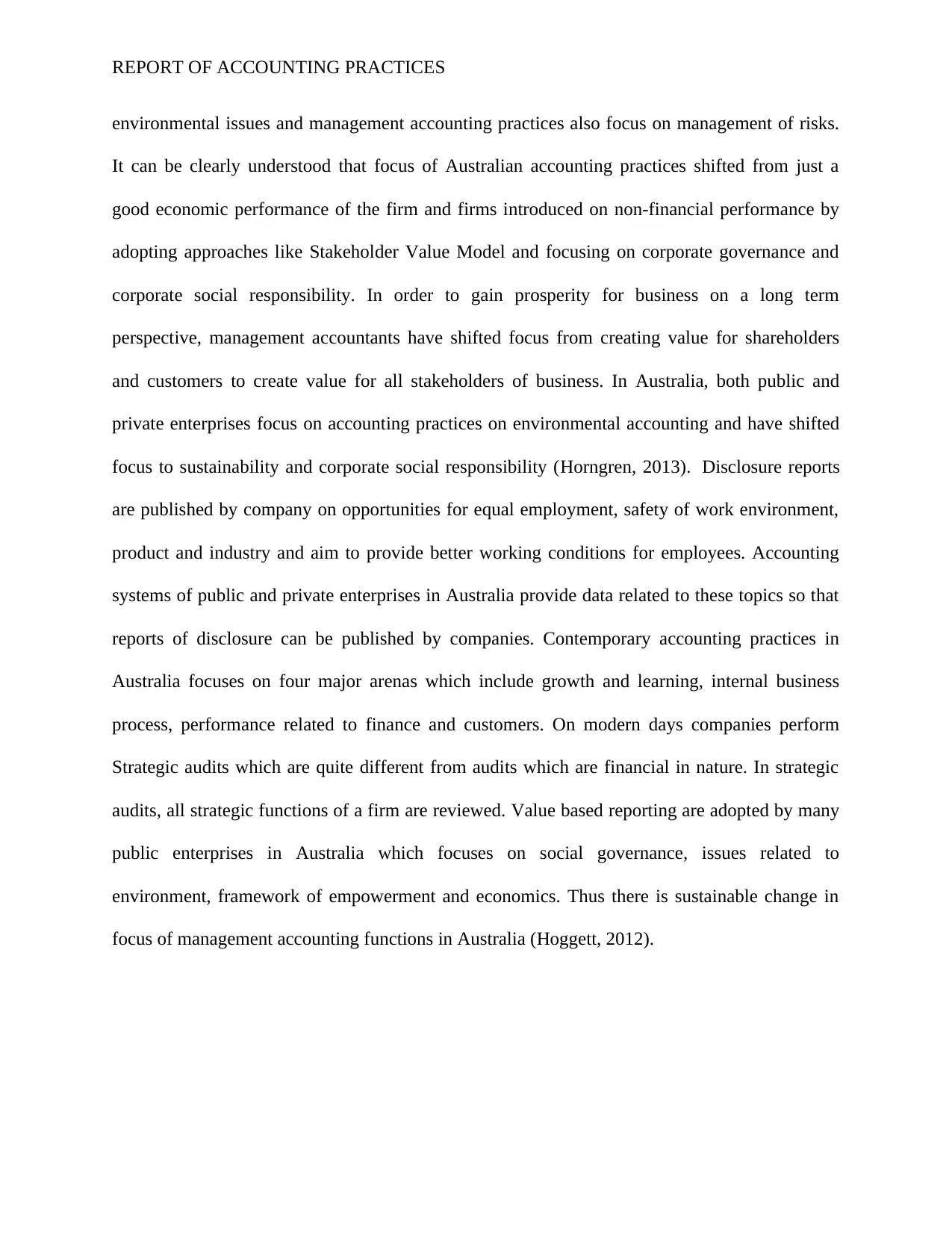
environmental issues and management accounting practices also focus on management of risks.
It can be clearly understood that focus of Australian accounting practices shifted from just a
good economic performance of the firm and firms introduced on non-financial performance by
adopting approaches like Stakeholder Value Model and focusing on corporate governance and
corporate social responsibility. In order to gain prosperity for business on a long term
perspective, management accountants have shifted focus from creating value for shareholders
and customers to create value for all stakeholders of business. In Australia, both public and
private enterprises focus on accounting practices on environmental accounting and have shifted
focus to sustainability and corporate social responsibility (Horngren, 2013). Disclosure reports
are published by company on opportunities for equal employment, safety of work environment,
product and industry and aim to provide better working conditions for employees. Accounting
systems of public and private enterprises in Australia provide data related to these topics so that
reports of disclosure can be published by companies. Contemporary accounting practices in
Australia focuses on four major arenas which include growth and learning, internal business
process, performance related to finance and customers. On modern days companies perform
Strategic audits which are quite different from audits which are financial in nature. In strategic
audits, all strategic functions of a firm are reviewed. Value based reporting are adopted by many
public enterprises in Australia which focuses on social governance, issues related to
environment, framework of empowerment and economics. Thus there is sustainable change in
focus of management accounting functions in Australia (Hoggett, 2012).
⊘ This is a preview!⊘
Do you want full access?
Subscribe today to unlock all pages.

Trusted by 1+ million students worldwide
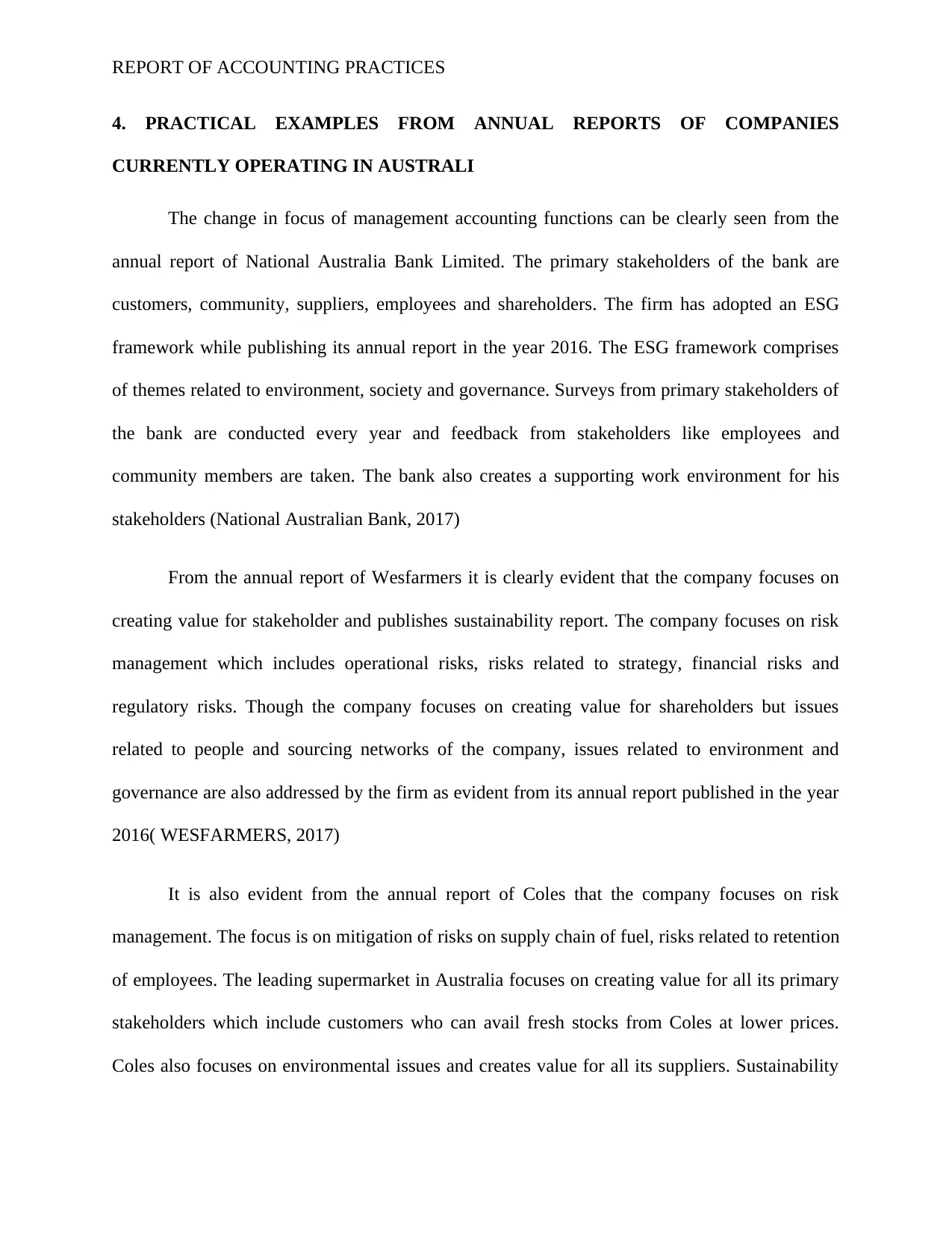
4. PRACTICAL EXAMPLES FROM ANNUAL REPORTS OF COMPANIES
CURRENTLY OPERATING IN AUSTRALI
The change in focus of management accounting functions can be clearly seen from the
annual report of National Australia Bank Limited. The primary stakeholders of the bank are
customers, community, suppliers, employees and shareholders. The firm has adopted an ESG
framework while publishing its annual report in the year 2016. The ESG framework comprises
of themes related to environment, society and governance. Surveys from primary stakeholders of
the bank are conducted every year and feedback from stakeholders like employees and
community members are taken. The bank also creates a supporting work environment for his
stakeholders (National Australian Bank, 2017)
From the annual report of Wesfarmers it is clearly evident that the company focuses on
creating value for stakeholder and publishes sustainability report. The company focuses on risk
management which includes operational risks, risks related to strategy, financial risks and
regulatory risks. Though the company focuses on creating value for shareholders but issues
related to people and sourcing networks of the company, issues related to environment and
governance are also addressed by the firm as evident from its annual report published in the year
2016( WESFARMERS, 2017)
It is also evident from the annual report of Coles that the company focuses on risk
management. The focus is on mitigation of risks on supply chain of fuel, risks related to retention
of employees. The leading supermarket in Australia focuses on creating value for all its primary
stakeholders which include customers who can avail fresh stocks from Coles at lower prices.
Coles also focuses on environmental issues and creates value for all its suppliers. Sustainability
Paraphrase This Document
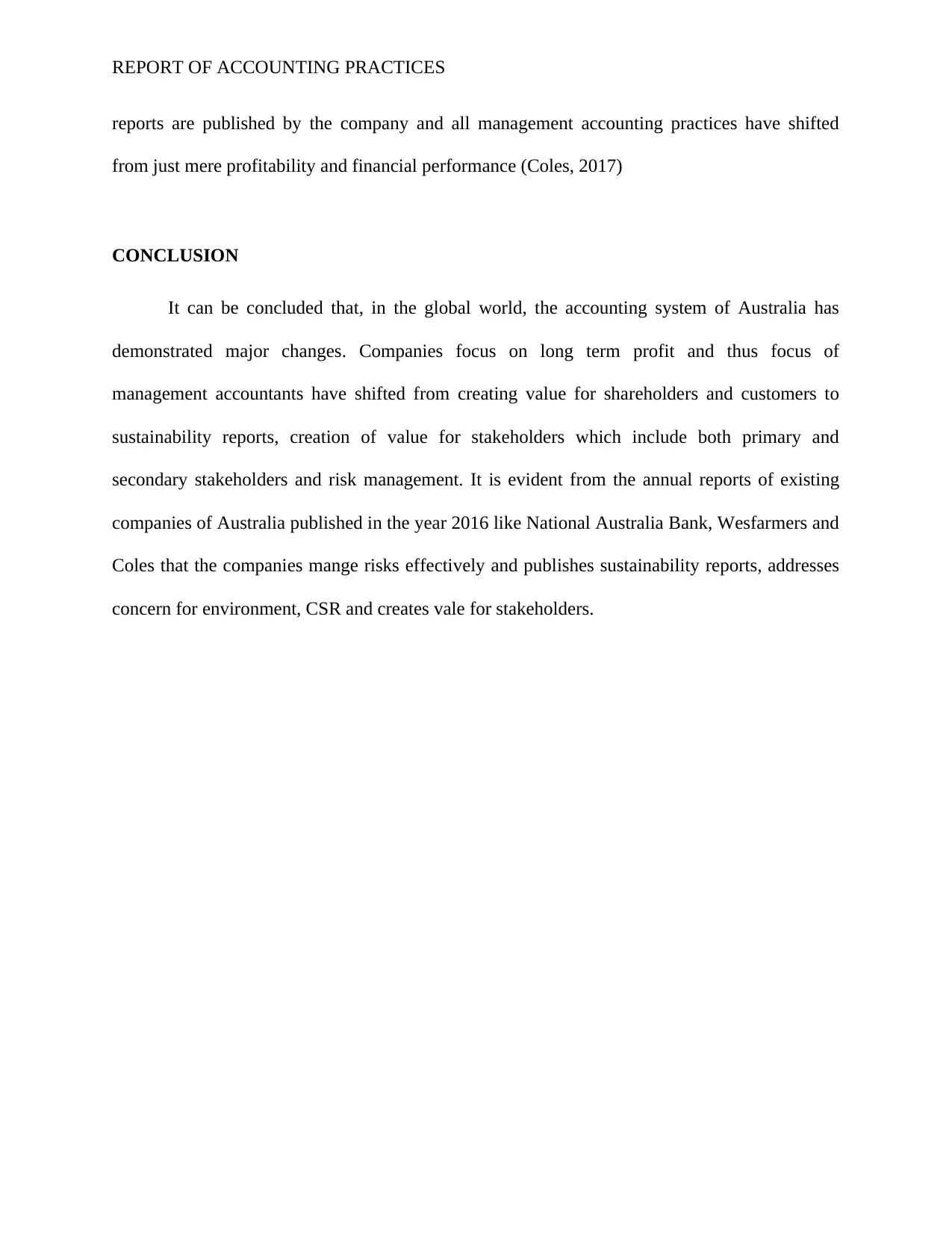
reports are published by the company and all management accounting practices have shifted
from just mere profitability and financial performance (Coles, 2017)
CONCLUSION
It can be concluded that, in the global world, the accounting system of Australia has
demonstrated major changes. Companies focus on long term profit and thus focus of
management accountants have shifted from creating value for shareholders and customers to
sustainability reports, creation of value for stakeholders which include both primary and
secondary stakeholders and risk management. It is evident from the annual reports of existing
companies of Australia published in the year 2016 like National Australia Bank, Wesfarmers and
Coles that the companies mange risks effectively and publishes sustainability reports, addresses
concern for environment, CSR and creates vale for stakeholders.
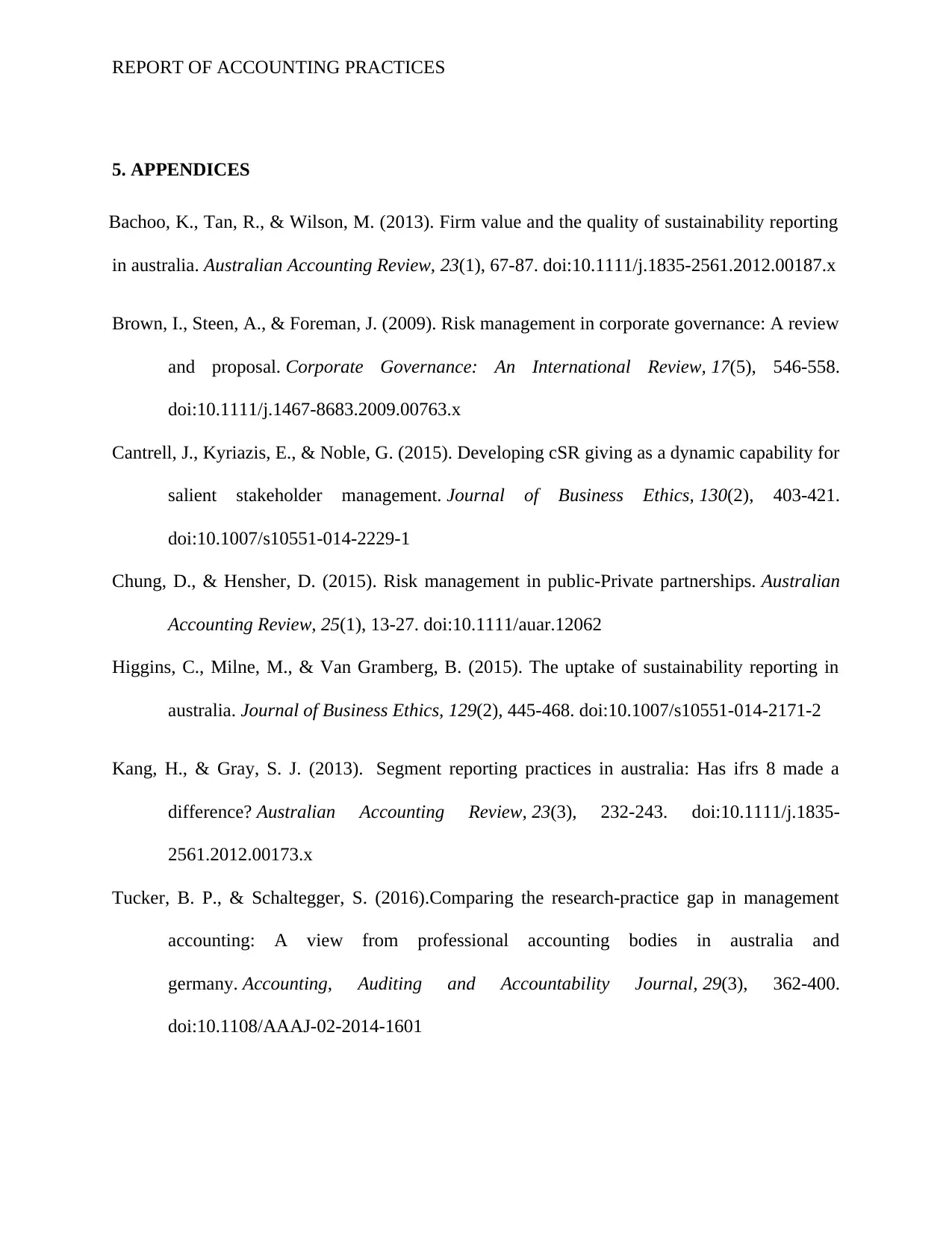
5. APPENDICES
Bachoo, K., Tan, R., & Wilson, M. (2013). Firm value and the quality of sustainability reporting
in australia. Australian Accounting Review, 23(1), 67-87. doi:10.1111/j.1835-2561.2012.00187.x
Brown, I., Steen, A., & Foreman, J. (2009). Risk management in corporate governance: A review
and proposal. Corporate Governance: An International Review, 17(5), 546-558.
doi:10.1111/j.1467-8683.2009.00763.x
Cantrell, J., Kyriazis, E., & Noble, G. (2015). Developing cSR giving as a dynamic capability for
salient stakeholder management. Journal of Business Ethics, 130(2), 403-421.
doi:10.1007/s10551-014-2229-1
Chung, D., & Hensher, D. (2015). Risk management in public-Private partnerships. Australian
Accounting Review, 25(1), 13-27. doi:10.1111/auar.12062
Higgins, C., Milne, M., & Van Gramberg, B. (2015). The uptake of sustainability reporting in
australia. Journal of Business Ethics, 129(2), 445-468. doi:10.1007/s10551-014-2171-2
Kang, H., & Gray, S. J. (2013). Segment reporting practices in australia: Has ifrs 8 made a
difference? Australian Accounting Review, 23(3), 232-243. doi:10.1111/j.1835-
2561.2012.00173.x
Tucker, B. P., & Schaltegger, S. (2016).Comparing the research-practice gap in management
accounting: A view from professional accounting bodies in australia and
germany. Accounting, Auditing and Accountability Journal, 29(3), 362-400.
doi:10.1108/AAAJ-02-2014-1601
⊘ This is a preview!⊘
Do you want full access?
Subscribe today to unlock all pages.

Trusted by 1+ million students worldwide
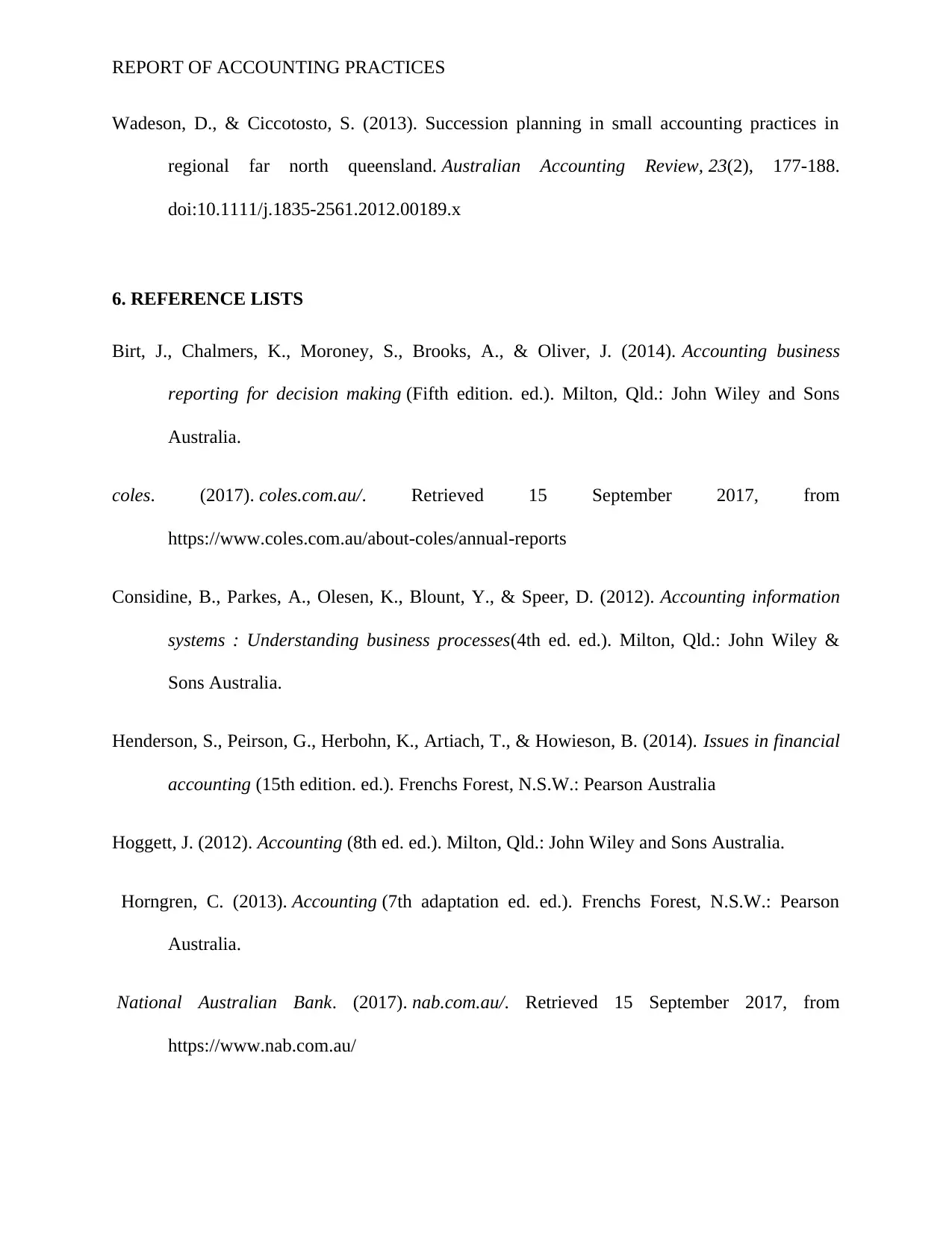
Wadeson, D., & Ciccotosto, S. (2013). Succession planning in small accounting practices in
regional far north queensland. Australian Accounting Review, 23(2), 177-188.
doi:10.1111/j.1835-2561.2012.00189.x
6. REFERENCE LISTS
Birt, J., Chalmers, K., Moroney, S., Brooks, A., & Oliver, J. (2014). Accounting business
reporting for decision making (Fifth edition. ed.). Milton, Qld.: John Wiley and Sons
Australia.
coles. (2017). coles.com.au/. Retrieved 15 September 2017, from
https://www.coles.com.au/about-coles/annual-reports
Considine, B., Parkes, A., Olesen, K., Blount, Y., & Speer, D. (2012). Accounting information
systems : Understanding business processes(4th ed. ed.). Milton, Qld.: John Wiley &
Sons Australia.
Henderson, S., Peirson, G., Herbohn, K., Artiach, T., & Howieson, B. (2014). Issues in financial
accounting (15th edition. ed.). Frenchs Forest, N.S.W.: Pearson Australia
Hoggett, J. (2012). Accounting (8th ed. ed.). Milton, Qld.: John Wiley and Sons Australia.
Horngren, C. (2013). Accounting (7th adaptation ed. ed.). Frenchs Forest, N.S.W.: Pearson
Australia.
National Australian Bank. (2017). nab.com.au/. Retrieved 15 September 2017, from
https://www.nab.com.au/
Paraphrase This Document
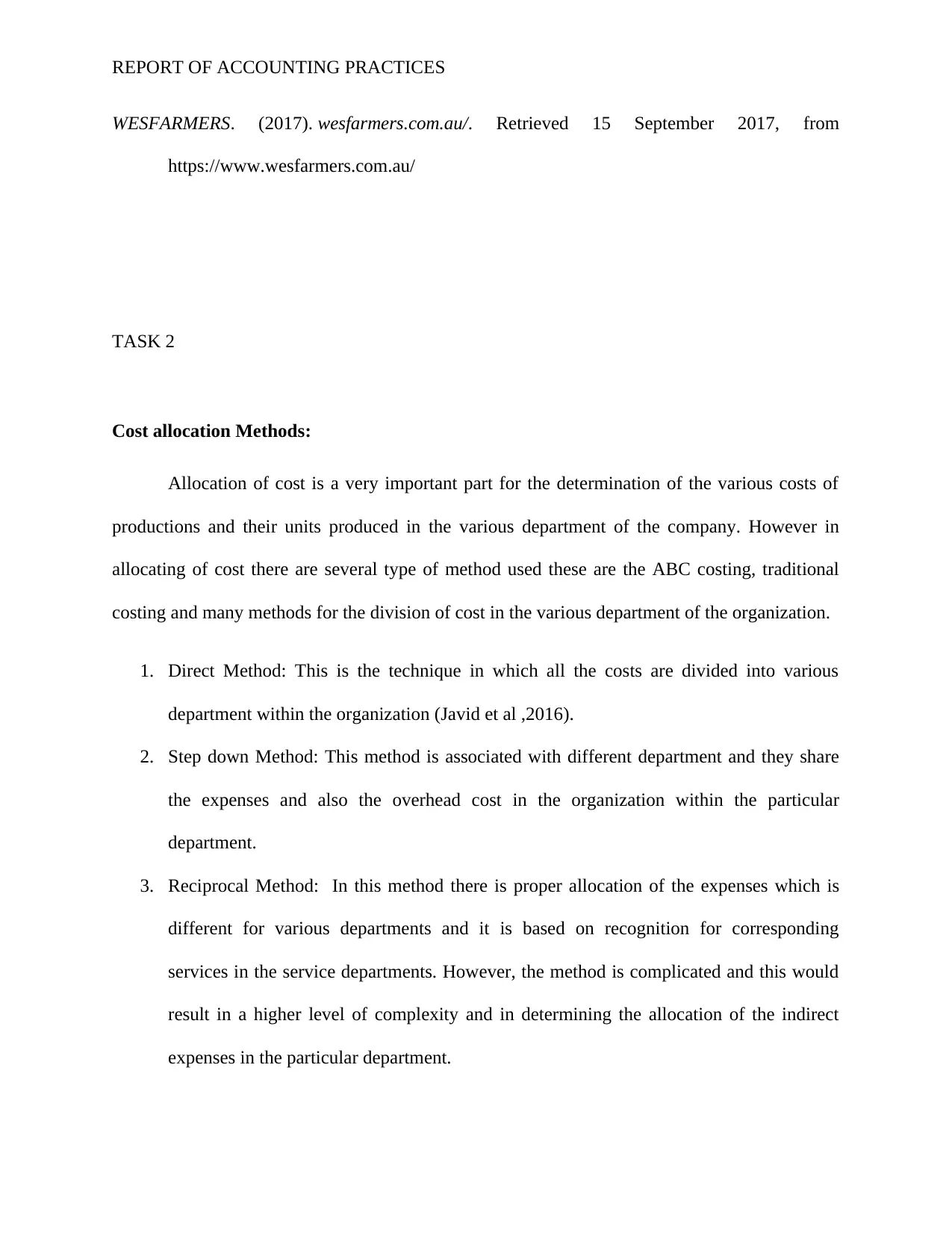
WESFARMERS. (2017). wesfarmers.com.au/. Retrieved 15 September 2017, from
https://www.wesfarmers.com.au/
TASK 2
Cost allocation Methods:
Allocation of cost is a very important part for the determination of the various costs of
productions and their units produced in the various department of the company. However in
allocating of cost there are several type of method used these are the ABC costing, traditional
costing and many methods for the division of cost in the various department of the organization.
1. Direct Method: This is the technique in which all the costs are divided into various
department within the organization (Javid et al ,2016).
2. Step down Method: This method is associated with different department and they share
the expenses and also the overhead cost in the organization within the particular
department.
3. Reciprocal Method: In this method there is proper allocation of the expenses which is
different for various departments and it is based on recognition for corresponding
services in the service departments. However, the method is complicated and this would
result in a higher level of complexity and in determining the allocation of the indirect
expenses in the particular department.
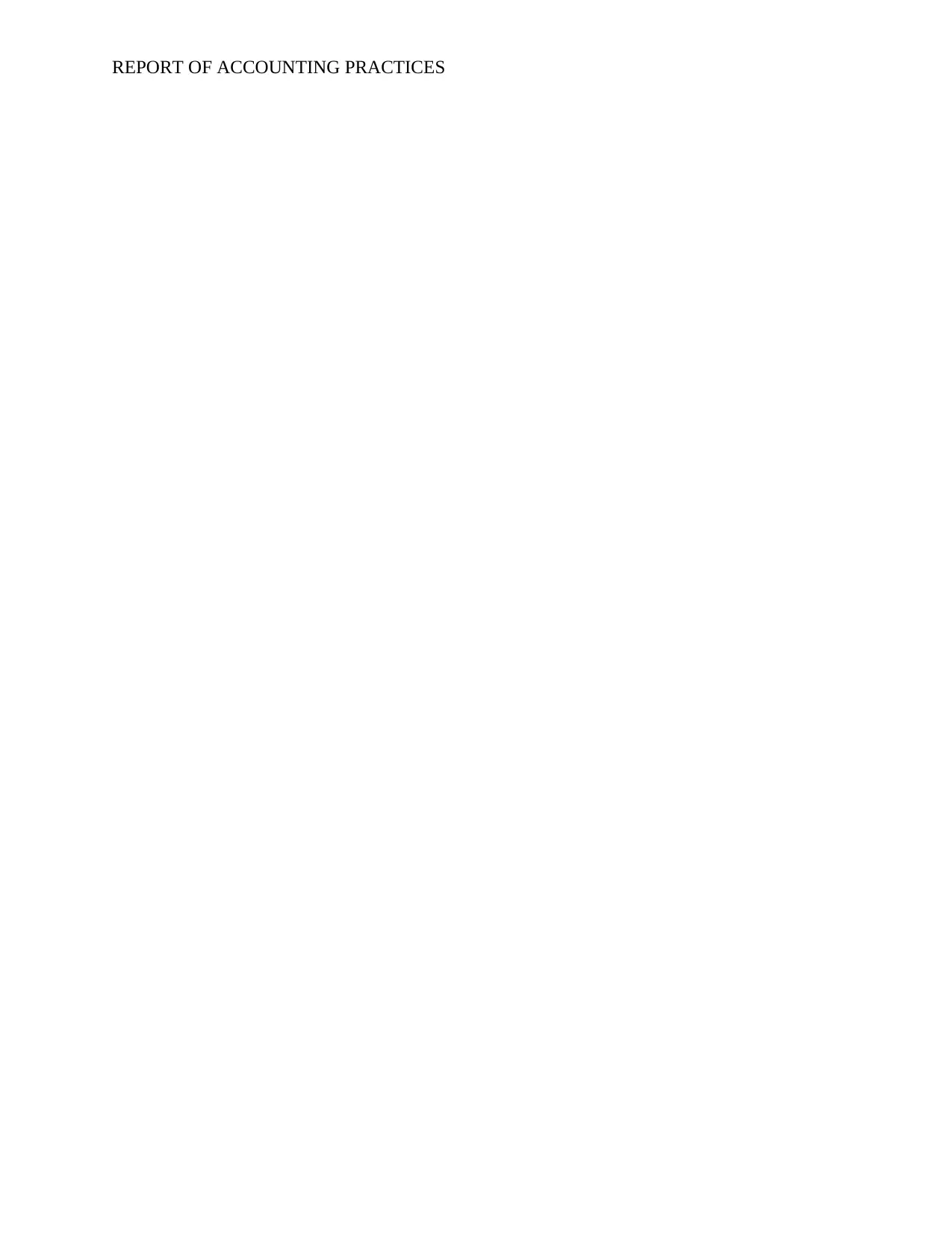
⊘ This is a preview!⊘
Do you want full access?
Subscribe today to unlock all pages.

Trusted by 1+ million students worldwide
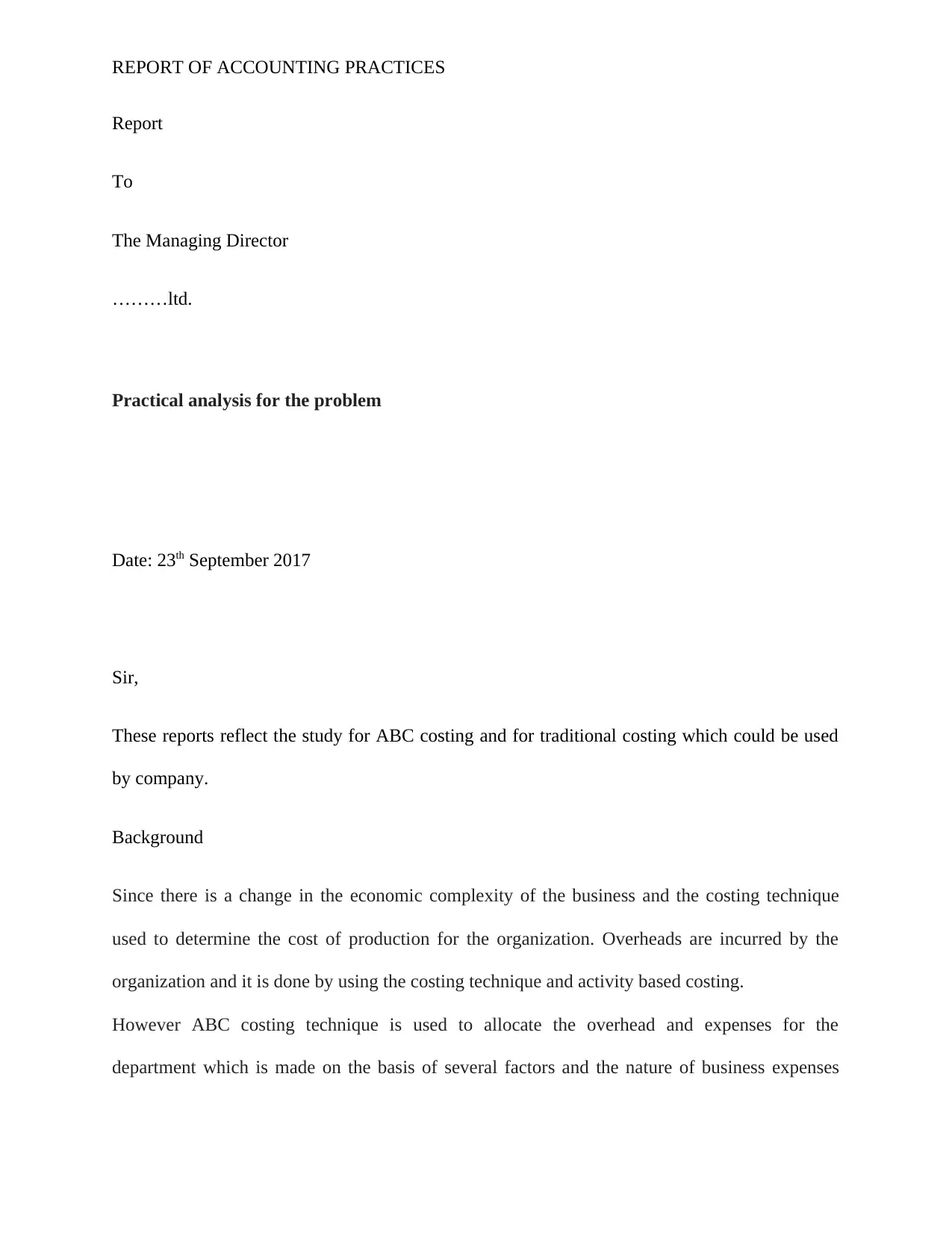
Report
To
The Managing Director
………ltd.
Practical analysis for the problem
Date: 23th September 2017
Sir,
These reports reflect the study for ABC costing and for traditional costing which could be used
by company.
Background
Since there is a change in the economic complexity of the business and the costing technique
used to determine the cost of production for the organization. Overheads are incurred by the
organization and it is done by using the costing technique and activity based costing.
However ABC costing technique is used to allocate the overhead and expenses for the
department which is made on the basis of several factors and the nature of business expenses
Paraphrase This Document
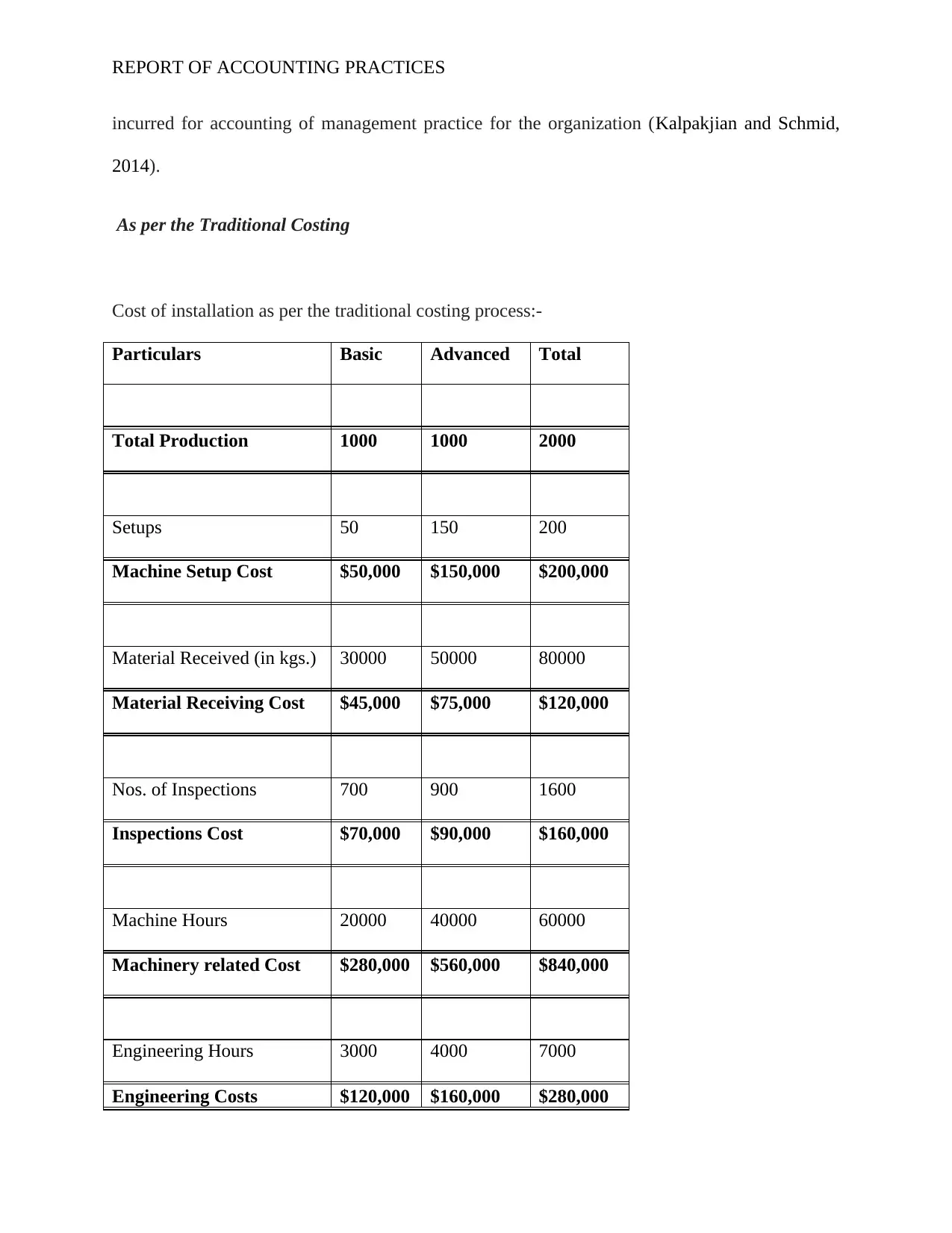
incurred for accounting of management practice for the organization (Kalpakjian and Schmid,
2014).
As per the Traditional Costing
Cost of installation as per the traditional costing process:-
Particulars Basic Advanced Total
Total Production 1000 1000 2000
Setups 50 150 200
Machine Setup Cost $50,000 $150,000 $200,000
Material Received (in kgs.) 30000 50000 80000
Material Receiving Cost $45,000 $75,000 $120,000
Nos. of Inspections 700 900 1600
Inspections Cost $70,000 $90,000 $160,000
Machine Hours 20000 40000 60000
Machinery related Cost $280,000 $560,000 $840,000
Engineering Hours 3000 4000 7000
Engineering Costs $120,000 $160,000 $280,000
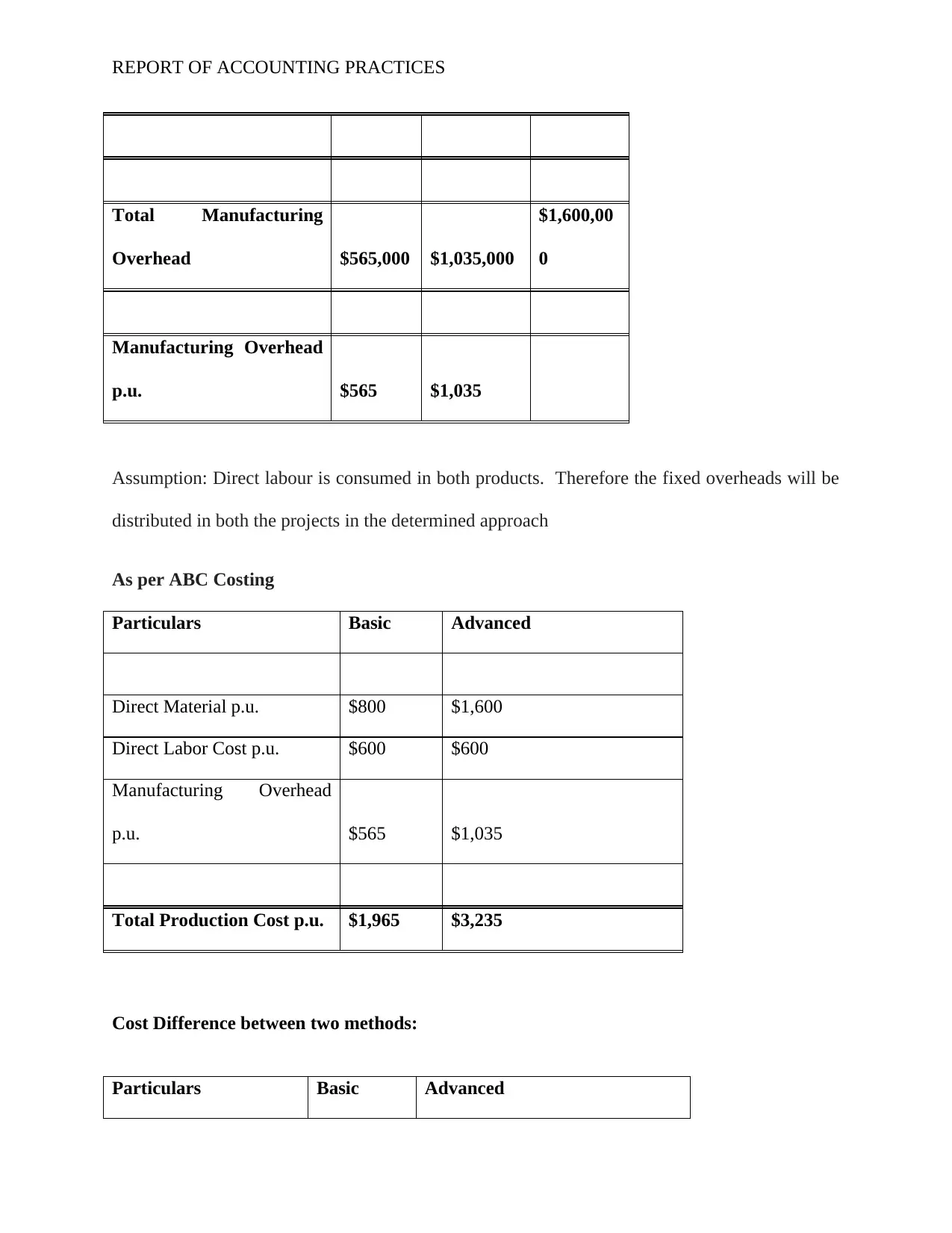
Total Manufacturing
Overhead $565,000 $1,035,000
$1,600,00
0
Manufacturing Overhead
p.u. $565 $1,035
Assumption: Direct labour is consumed in both products. Therefore the fixed overheads will be
distributed in both the projects in the determined approach
As per ABC Costing
Particulars Basic Advanced
Direct Material p.u. $800 $1,600
Direct Labor Cost p.u. $600 $600
Manufacturing Overhead
p.u. $565 $1,035
Total Production Cost p.u. $1,965 $3,235
Cost Difference between two methods:
Particulars Basic Advanced
⊘ This is a preview!⊘
Do you want full access?
Subscribe today to unlock all pages.

Trusted by 1+ million students worldwide
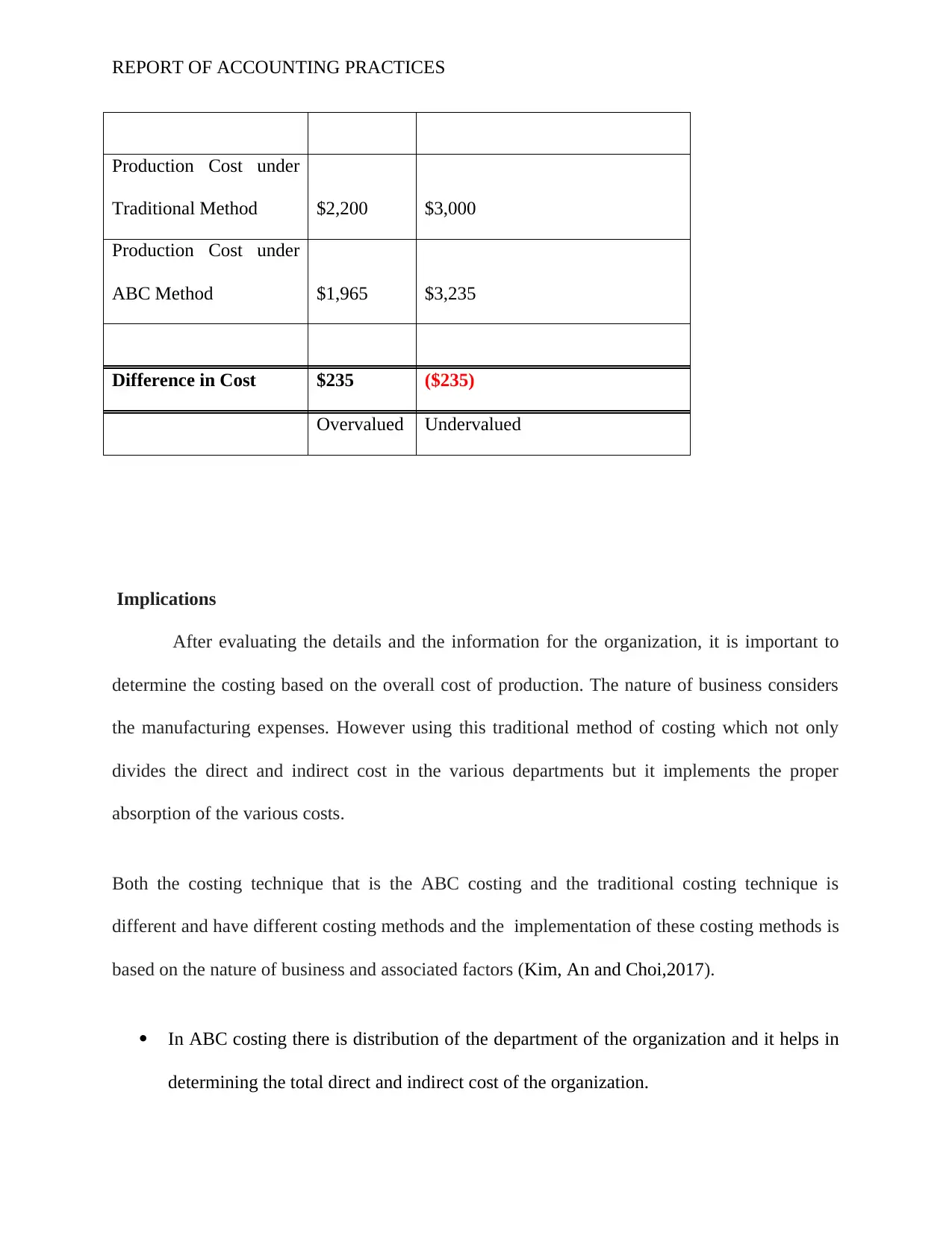
Production Cost under
Traditional Method $2,200 $3,000
Production Cost under
ABC Method $1,965 $3,235
Difference in Cost $235 ($235)
Overvalued Undervalued
Implications
After evaluating the details and the information for the organization, it is important to
determine the costing based on the overall cost of production. The nature of business considers
the manufacturing expenses. However using this traditional method of costing which not only
divides the direct and indirect cost in the various departments but it implements the proper
absorption of the various costs.
Both the costing technique that is the ABC costing and the traditional costing technique is
different and have different costing methods and the implementation of these costing methods is
based on the nature of business and associated factors (Kim, An and Choi,2017).
In ABC costing there is distribution of the department of the organization and it helps in
determining the total direct and indirect cost of the organization.
Paraphrase This Document
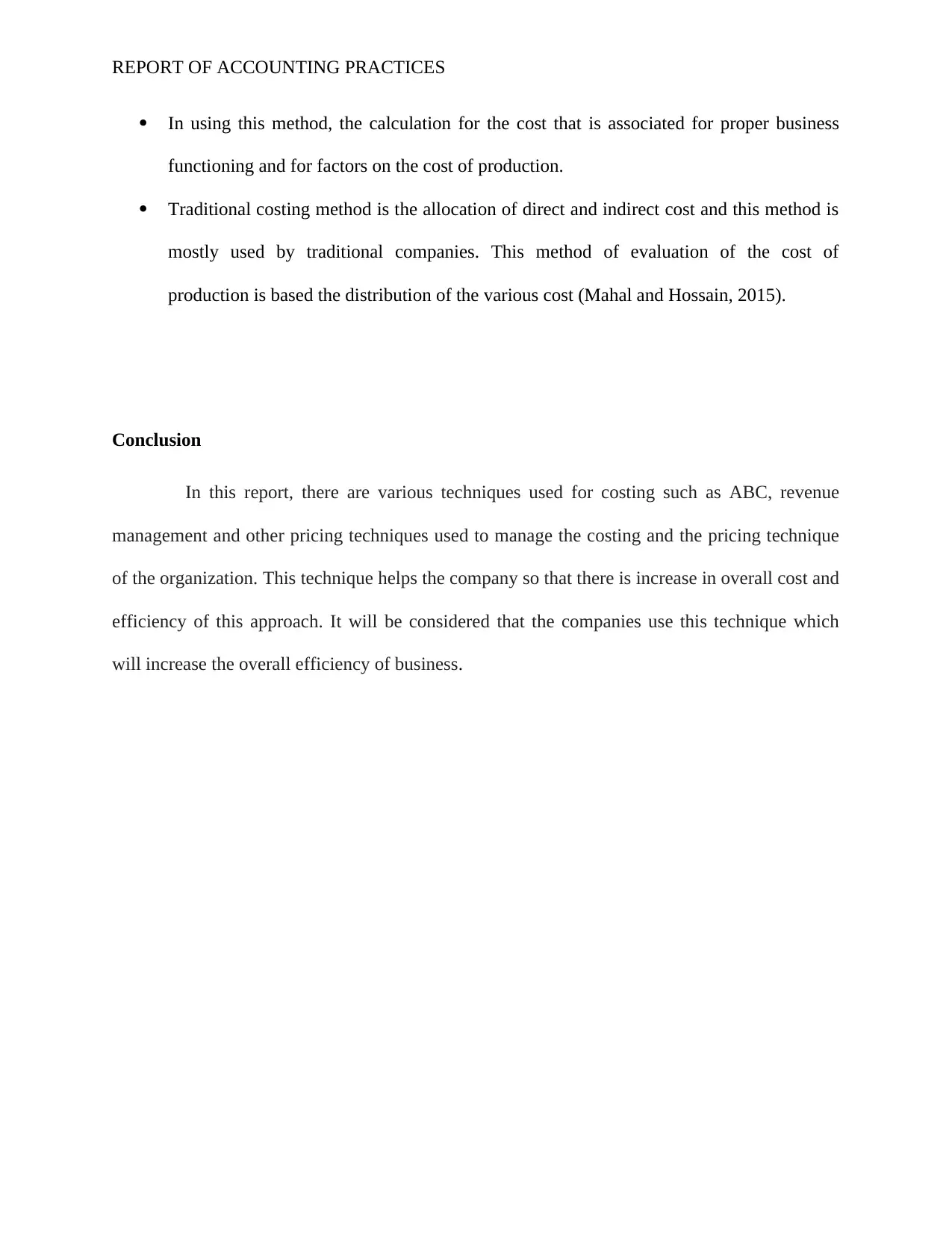
In using this method, the calculation for the cost that is associated for proper business
functioning and for factors on the cost of production.
Traditional costing method is the allocation of direct and indirect cost and this method is
mostly used by traditional companies. This method of evaluation of the cost of
production is based the distribution of the various cost (Mahal and Hossain, 2015).
Conclusion
In this report, there are various techniques used for costing such as ABC, revenue
management and other pricing techniques used to manage the costing and the pricing technique
of the organization. This technique helps the company so that there is increase in overall cost and
efficiency of this approach. It will be considered that the companies use this technique which
will increase the overall efficiency of business.
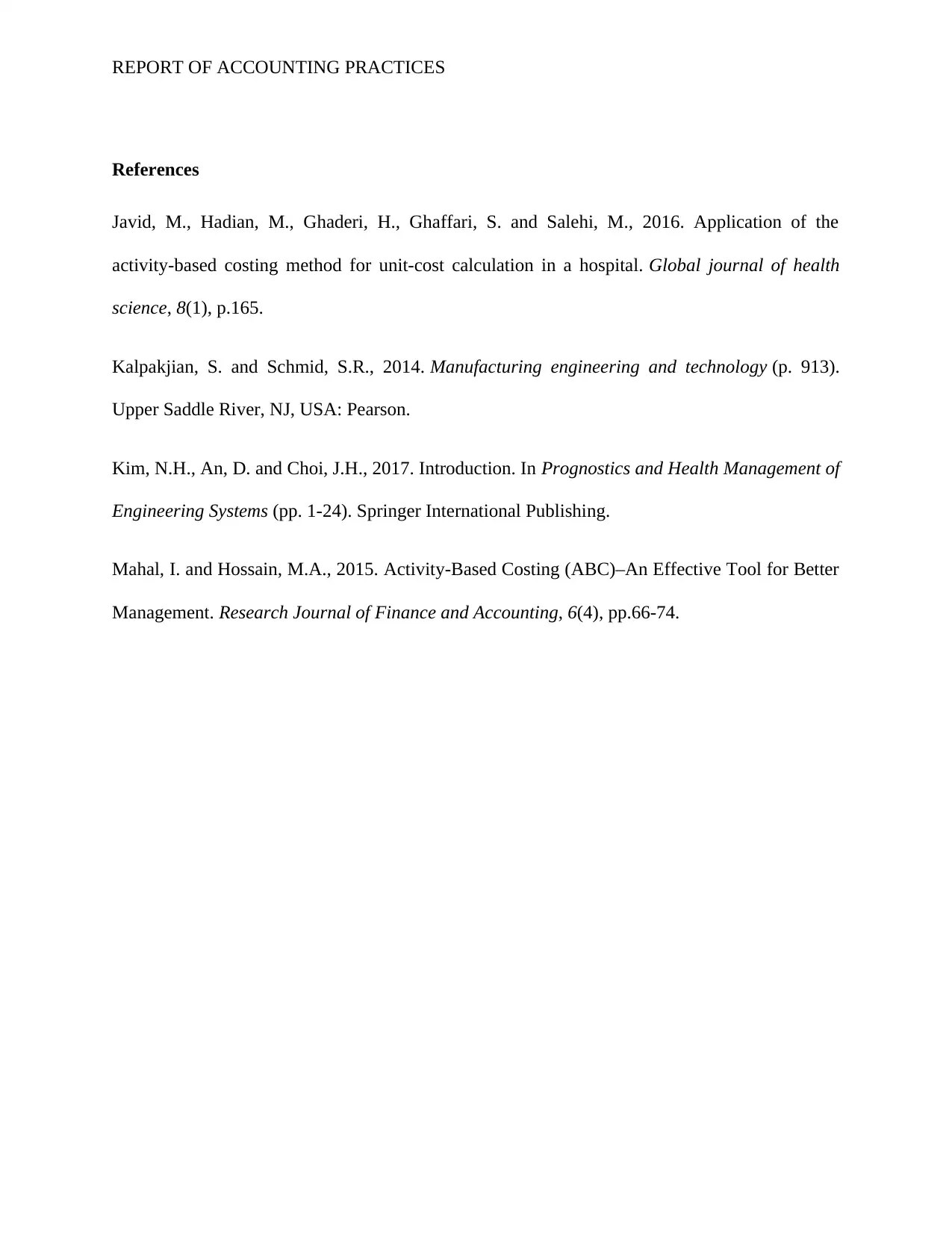
References
Javid, M., Hadian, M., Ghaderi, H., Ghaffari, S. and Salehi, M., 2016. Application of the
activity-based costing method for unit-cost calculation in a hospital. Global journal of health
science, 8(1), p.165.
Kalpakjian, S. and Schmid, S.R., 2014. Manufacturing engineering and technology (p. 913).
Upper Saddle River, NJ, USA: Pearson.
Kim, N.H., An, D. and Choi, J.H., 2017. Introduction. In Prognostics and Health Management of
Engineering Systems (pp. 1-24). Springer International Publishing.
Mahal, I. and Hossain, M.A., 2015. Activity-Based Costing (ABC)–An Effective Tool for Better
Management. Research Journal of Finance and Accounting, 6(4), pp.66-74.
⊘ This is a preview!⊘
Do you want full access?
Subscribe today to unlock all pages.

Trusted by 1+ million students worldwide
Related Documents
Your All-in-One AI-Powered Toolkit for Academic Success.
+13062052269
info@desklib.com
Available 24*7 on WhatsApp / Email
![[object Object]](/_next/static/media/star-bottom.7253800d.svg)
© 2024 | Zucol Services PVT LTD | All rights reserved.




